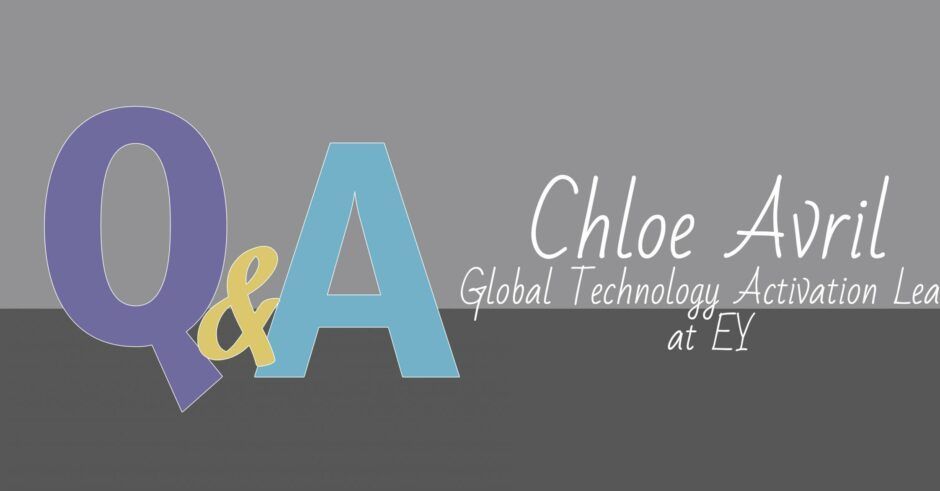We conducted a Q&A interview with Chloe Avril, Global Technology Activation Lead at EY, around innovation, creativity and how they affect business change.
Could you introduce yourself and what you do?
My name is Chloe Avril and I am the Global TAS Technology Activation Lead at EY. My role basically entails making sure that the technology products we develop are actually being adopted by the business and getting used as intended. Prior to this role, I led a number of large business transformation programmes, mostly focused on technology and culture change.
Innovation and creativity are sought after qualities in many organisations today, but are often hard to come across in the genuine nature. How would you define a culture of innovation and creativity – Are there any specific traits of a culture of innovation?
There definitely are! A culture of innovation requires first and foremost, an institutional permission to try new things, and to fail! The ability of an organisation to accept a level of controlled risk taking is key to allowing its people to innovate and try new things. The personal and organisational performance management metrics need to reflect that intent and recognise that trying and failing is better than playing it safe.
What is the importance of leaders creating a culture of innovation and creativity?
We live in an incredibly dynamic world where the order of things is constantly being disrupted by new technologies. Those who adapt and manage to develop an agile organisation will be able to adjust and survive. Those who remain as they currently are, will find themselves obsolete as the world progresses without them. Having an innovative culture is key to creating an agile organisation that will be able to adapt quickly and easily.
What do organisations need in order to become more innovative?
That depends on the organisation and where it is starting from. But for most organisations, this will require hiring the right people, streamlining their processes and changing the overall culture to allow for quicker decision-making and innovative thinking.
Is a culture of innovation actually required to innovate?
That’s a very good question. And the answer is: not necessarily. Innovation can happen despite the context in which it originates. But, there is no arguing that it is easier to innovate in an organisation that embraces controlled risk taking, accepts failure and encourages people to think outside of the box.
Many organisations are risk-adverse, which in turn reduces the opportunities to encourage innovation and creativity, can you change this inherent nature of risk adverse organisations to allow them to embrace innovation?
To a certain degree. Risk-aversion, like any cultural trait, can be reduced by undertaking a long-term culture change programme. However, these behaviour change initiatives can take years and are very difficult to sustain. Certain organisations are risk-averse by the nature of their trade (audit, law, financial services are all highly sensitive and require special care), and they probably will always maintain a lower threshold for risk taking than a technology start-up, for example. But they must nonetheless try, there is a way to travel between complete risk aversion and absolute agility.
Is there a set ‘blueprint’ to help leaders create a culture of innovation
If there was, I would be out of a job! Sadly not. There are some key behaviours and processes that can be altered to allow innovation to become more natural in a specific organisational environment, but the way you achieve these changes will vary significantly from one company to another, sometimes even between different departments within the same organisation!
As a leader, how can you change the way you work with your team to trust them more and increase their autonomy and freedom, with the intention of encouraging creativity and innovation?
A large component of behaviour change is the tone from the top. If leaders embrace controlled risk taking and trust their people to try different approaches, this creates a context when staff feel they have permission to innovate. Furthermore, it is essential for leaders to stop looking at failure as a negative outcome, but rather embrace the learnings that come from failing, and not penalise people who fail. As my children are taught in school: “FAIL stands for First Attempt In Learning”!
How much of a culture of innovation is affected by hiring?
Culture can be influenced from the ground up or from the top. I believe the tone from the top is essential, although it can of course be influenced from the bottom up. Hiring the right leaders will be essential. As we described above, organisations will need leaders who understand what it takes to change a culture and aren’t afraid to think differently. Hiring the right people on the ground will also be important to ensure they are able to take risks, think independently and take initiative. It is the overall context of the organisation that creates a culture, and that is entirely driven by its people.
There are many pieces that discuss the effect of the physical environment and how that affects the culture innovation and creativity – do you believe this to be the case?
Yes and no. Many organisations are pouring millions into redecorating their offices to look like co-working environments, complete with bean bags and free coffee. While this will play a key role in attracting the kind of talent who might otherwise be put off by a large organisation’s corporate setting, I am not sure it directly leads to a new culture within the organisation. It’s a nicer environment to work in, encourages more collaboration, but if staff aren’t interested in speaking to each other, having a great work environment won’t make a big difference!
Is there one specific piece of advice for encouraging a culture of innovation?
Take it seriously and commit to it, it is a long-term endeavour.
This interview is exclusive to The Business Transformation Network.


